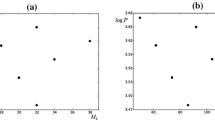Abstract
We consider a procedure for calculating the pair correlation function in the context of cluster variation methods (CVM). As specific cases, we study the pair correlation function in the paramagnetic phase of the Ising model with nearest neighbors, next to nearest neighbors, and plaquette interactions in two and three dimensions. In presence of competing interactions, the so-called disorder line separates in the paramagnetic phase a region where the correlation function has the usual exponential behavior from a region where the correlation has an oscillating, exponentially damped behavior. In two dimensions, using the plaquette as the maximal cluster of the CVM approximation, we calculate the phase diagram and the disorder line for a case where a comparison is possible with known results for the eight-vertex model. In three dimensions, in the CVM cube approximation, we calculate the phase diagram and the disorder line in some cases of particular interest. The relevance of our results for experimental systems like mixtures of oil, water, and surfactant is also discussed.
Similar content being viewed by others
REFERENCES
R. Kikuchi, Phys. Rev. 81:988 (1951).
G. An, J. Stat. Phys. 52:727 (1988); T. Morita, J. Stat. Phys. 59:819 (1990).
We observe that the CVM has also been used in combination with Padé approximants to estimate critical exponents. See A. Pelizzola, Phys. Rev. E 49:R2503 (1994); ib. 53:5825 (1996).
See, e.g., A. Pelizzola, Physica A 211:107 (1994).
J. M. Sanchez, Physica 111A:200 (1982).
A. Finel and D. de Fontaine, J. Stat. Phys. 43:645 (1986).
R. Kikuchi, J. Chem. Phys. 60:1071 (1974).
R. J. Baxter, Exactly Solved Models in Statistical Mechanics (Academic Press, London, 1982).
M. Karowski, J. Phys. A 19:3375 (1986).
A. Cappi, P. Colangelo, G. Gonnella, and A. Maritan, Nucl. Phys. B 370:659 (1992).
G. Gonnella, S. Lise, and A. Maritan, Europhys. Lett. 32:735 (1995).
P. Colangelo, G. Gonnella, and A. Maritan, Phys. Rev. E 47:411 (1993).
R. V. Ambartzumian, G. S. Sukiasian, G. K. Savvidy, and K. G. Savvidy, Phys. Lett. B 275:99 (1992).
E. N. M. Cirillo, G. Gonnella, D. A. Johnston, and A. Pelizzola, Phys. Lett. A 226:59 (1997).
M. E. Fisher and B. Widom, J. Chem. Phys. 50:3756 (1968).
See, e. g., Gompper and M. Schick, Self-assembling Amphiphilic Systems, in Phase Transitions and Critical Phenomena, C. Domb and J. L. Lebowitz, eds. (Academic, London, 1994).
J. L. Moran-Lopez, F. Aguilera-Granja, and J. M. Sanchez, J. Phys. Condense Matter 6:9759 (1994).
C. Buzano and M. Pretti, Phys. Revs B 56:636 (1997).
B. Widom, J. Chem. Phys. 90:2437 (1989).
J. Stephenson, J. Math. Phys. 11:420 (1970); Phys. Rev. B 1:4405 (1970).
I. Peschel and F. Rys, Phys. Lett. A 91:187 (1982).
I. G. Enting, J. Phys. C: Solid State Phys. 10:1379 (1977).
Author information
Authors and Affiliations
Rights and permissions
About this article
Cite this article
Cirillo, E.N.M., Gonnella, G., Troccoli, M. et al. Correlation Functions by Cluster Variation Method for Ising Model with NN, NNN, and Plaquette Interactions. Journal of Statistical Physics 94, 67–89 (1999). https://doi.org/10.1023/A:1004507211976
Issue Date:
DOI: https://doi.org/10.1023/A:1004507211976




